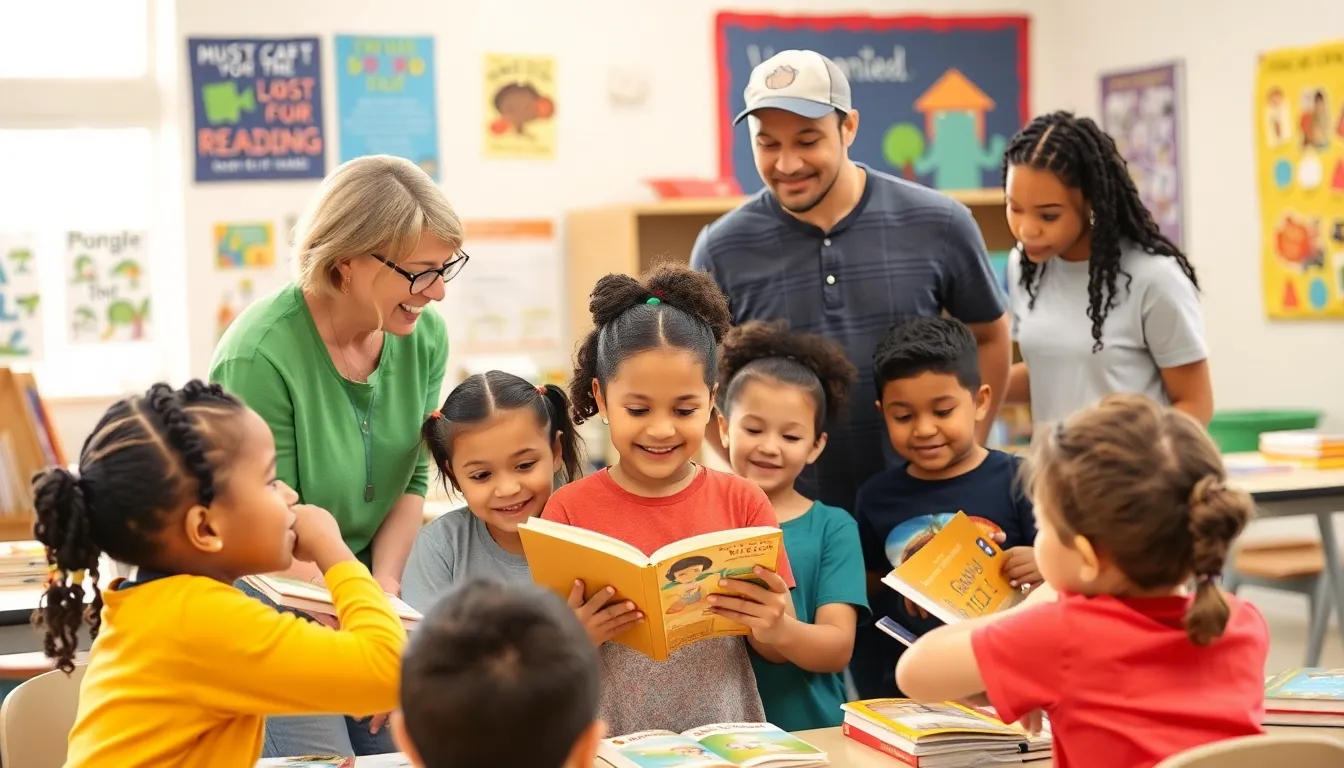Table of Contents
ToggleIn a world overflowing with information, literacy isn’t just a nice-to-have; it’s a superpower. Imagine navigating life without the ability to read a menu or decipher a road sign. Literacy programs swoop in like caped crusaders, transforming everyday folks into confident readers and writers. They’re not just about letters and words; they’re about unlocking potential and opening doors to new opportunities.
These programs come in all shapes and sizes, from community workshops to online courses, each designed to make learning engaging and effective. Whether someone’s tackling the basics or diving into advanced skills, literacy programs have something for everyone. So why not take the plunge? After all, who wouldn’t want to impress friends with their newfound ability to read the fine print on a contract—or at least the instructions for assembling that mysterious piece of furniture?
Overview of Literacy Programs
Literacy programs play a crucial role in developing reading and writing skills across diverse communities. Many programs operate through local organizations, schools, and libraries, making them accessible to individuals of all ages. These initiatives often include tailored curriculum components designed to meet varying educational needs.
Community workshops often serve as effective platforms for hands-on learning. Classes focus on practical skills, such as reading comprehension and basic writing. Attendees engage in interactive discussions, promoting a collaborative learning environment.
Online courses also provide flexible options for learners. Participants can access instructional materials anytime and anywhere, accommodating different schedules. This format encourages self-paced progress, enabling individuals to master literacy concepts at their convenience.
Government and non-profit sectors frequently fund literacy programs. Organizations such as the National Adult Literacy Agency in the United States emphasize the importance of sustained funding for these initiatives. Research consistently shows that improving literacy rates positively impacts economic growth and social well-being.
Targeted programs for specific populations exist to address unique challenges. For instance, literacy support can focus on immigrants, children, or adults with limited educational backgrounds. These specialized programs often use culturally relevant materials to make learning more relatable.
Success in literacy programs is measurable through various assessment tools. Programs often track improvements in reading levels and writing proficiency, showcasing progress over time. Effective instruction methods typically incorporate diverse strategies to engage different learning styles.
Ultimately, literacy programs foster empowerment and self-sufficiency, equipping individuals with essential skills to thrive in society. By participating in these programs, people unlock new opportunities for personal and professional growth.
Types of Literacy Programs


Literacy programs come in various forms, addressing the unique needs of different communities. These programs primarily focus on enhancing reading and writing skills for both adults and children.
Adult Literacy Programs
Adult literacy programs target individuals aged 16 and over, focusing on basic reading and writing skills. These programs often operate in community colleges, libraries, and local non-profit organizations. Instruction usually covers essential skills necessary for everyday life, such as reading job applications and writing resumes. Some adult programs also emphasize digital literacy, preparing participants for technology-enhanced workplaces. Many of these programs offer flexible schedules to accommodate working adults, allowing for participation without disrupting their professional or personal commitments.
Children’s Literacy Programs
Children’s literacy programs aim to develop early reading and writing skills in younger populations. These initiatives typically engage students from pre-school through elementary school. Schools, libraries, and community centers often sponsor these programs, utilizing interactive methods to promote learning. Reading clubs, storytelling sessions, and tutoring offer fun, engaging ways to build language skills. Many programs also involve parents, fostering a supportive home reading environment that enhances children’s literacy development. By focusing on age-appropriate materials, these programs spark enthusiasm for reading during critical learning stages.
Effectiveness of Literacy Programs
Literacy programs demonstrate significant impact in enhancing reading and writing proficiency. They offer pathways for personal and professional growth, addressing diverse educational needs.
Measuring Success in Literacy Programs
Success in literacy programs is easily measurable through set assessment tools. Standardized tests evaluate improvement in reading and writing skills. Participant feedback provides insights into engagement and satisfaction levels. These programs often track progress over time, allowing instructors to adjust teaching methods as needed. Increased participation rates frequently indicate broader community engagement. Programs successfully adapting curricula based on evaluations showcase their commitment to continuous improvement.
Case Studies of Successful Programs
Some successful literacy programs illustrate their effectiveness through community impact. The Baltimore Reads initiative improved adult literacy through personalized instruction and support. By utilizing volunteer tutors, it fostered a safe learning environment. In New York City, the Reach Out and Read program focused on children’s literacy, encouraging parents to read to their children. This enriched their home reading experience, leading to improved academic performance. Both programs exemplify how tailored approaches can address specific community needs and facilitate substantial educational outcomes.
Challenges Faced by Literacy Programs
Literacy programs encounter several challenges that can affect their effectiveness. Identifying these obstacles is essential for improvement.
Funding and Resources
Securing adequate funding represents a significant hurdle for many literacy programs. Government allocations, private donations, and grants often fluctuate, creating uncertainty in budgeting. Programs may rely heavily on volunteers, which could limit the number of classes offered. Scarcity of materials also poses a problem, as outdated resources can hinder learning. Organizations like the National Adult Literacy Agency emphasize the need for sustained financial support to maintain operations. Additionally, administrators often face difficulty in marketing programs effectively, resulting in lower participation rates.
Community Engagement
Community engagement plays a vital role in the success of literacy programs. Many individuals remain unaware of available resources, which can stem from a lack of outreach. Building trust within communities requires consistent involvement and communication. Therefore, programs that involve local leaders can foster greater participation. Collaborative partnerships with schools, libraries, and other organizations can enhance visibility and support. Immigrant and marginalized populations may face unique challenges, including language barriers, so creating culturally responsive initiatives remains critical. Programs must continually adapt to meet the changing needs of their communities, ensuring inclusivity and relevance.
Future of Literacy Programs
Innovative approaches will shape the future of literacy programs. Technology integration enhances learning experiences by introducing digital tools and resources. Mobile applications provide on-the-go access to educational materials, making it easier for users to practice reading and writing skills anywhere. Moreover, personalized learning experiences address individual needs, allowing participants to progress at their own pace.
Collaborative partnerships play a critical role in expanding these programs. Local schools, libraries, and organizations often team up to share resources and expertise, improving community outreach. These collaborations help ensure that literacy programs are relevant and accessible to diverse populations. Additional investment in funding streams is essential, as government and philanthropic support can drive sustainability.
Data-driven strategies will guide future improvements. Analyzing participant assessment results highlights the effectiveness of various teaching methods. Communities can tailor their programs based on feedback, ensuring they meet the evolving needs of learners. Incorporating real-world contexts strengthens the connection between literacy skills and daily life, particularly for adults in the workforce.
Engagement with families remains vital. Initiatives that involve parents create supportive environments that foster children’s literacy development. Engaging the entire community contributes to a culture of reading and writing, further enhancing program effectiveness.
Ample resources are available to develop workforce readiness and digital literacy skills. Equipping adults with these essential skills prepares them for jobs in an increasingly digital economy. Encouraging local businesses to partner with literacy programs can create pathways to employment.
Strong outreach efforts will increase awareness and participation. Targeted campaigns can reach marginalized communities and improve program visibility. Literacy initiatives must remain adaptable, ensuring they meet the demands of a rapidly changing society.




